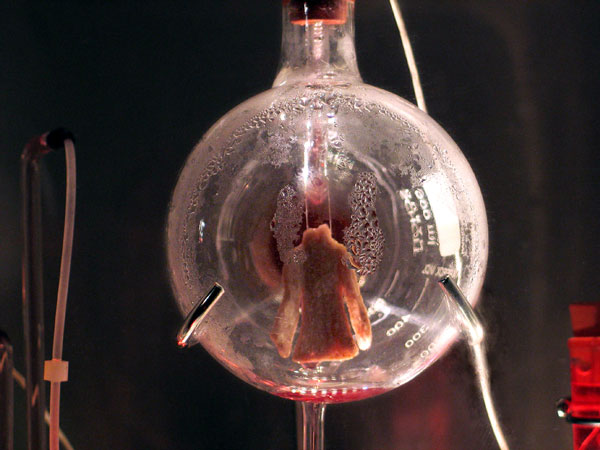Posts Tagged ‘bio art’
Frankensteinian Art?
My studies of researching digital technology and incorporating it into my traditional sculpting processes is part of what I am doing for my graduate degree at Goddard. It has taken me to places I would have never dreamed of going. Several months ago while researching 3d printers I began to realize that individuals were pushing anything they could through the printers to see what would happen, metal, ceramic, even glass. It was then that I wondered about biology. And I was certainly thrown for a loop when I found that they were printing bone, skin and now even organs. I wrote about this and had several links to articles about the subject in the October 28th blog article, I’m a genius! 3D Printing of the Human Organs?
I did, at that time, however, happen upon another artist’s work that after finding and reading I quickly clicked off of. The project has haunted me since then. There was such uneasiness when I first happened upon it that I didn’t even put it in my college bibliography. I am wondering now, why. Why am I so uneasy? It was exciting for me to find that science is now printing biology, and that someday, if I need a kidney I might be able to have my own kidney printed. But incorporating this other type of biology into art left me feeling uncomfortable. The topic has come up more than once since this first encounter with Stelarc’s art piece The Partial Head. The Partial Head is a prosthetic portrait of the artist that is computer generated and can talk to the viewer. This portrait is digitally printed and then seeded with living cells. Of course, the artwork needed a bioreactor/incubator circulatory system to survive. It only lived a week before becoming contaminated and “died.”
The Partial Head website acknowledges the collaboration of, The Tissue Culture & Arts Project (TC&A). http://www.tca.uwa.edu.au/ In a Leonardo Journal, article entitled, Growing Semi-Living Sculpture: The Tissue Culture & Art Project by Oron Catts and Ionat Zurr it state that they use “living tissue to create/grow semi-living object/sculptures and to research the technologies involved in such a task.” I need to examine, in my own mind, why creating organs to extend life, and using living cells to create art feels so different to me. Though both remind me of the scene from the movie Frankenstein.
Victor Moritz: Henry – In the name of God!
Henry Frankenstein: Oh, in the name of God! Now I know what it feels like to be God!
Is it my cultural upbringing that makes me uneasy about this? I have warned myself to be careful. Some fear is healthy; it does keep us from danger, however, it can also keep us from exploration. The difficulty is in knowing when have we gone too far.
Doctor Waldman: You have created a monster, and it will destroy you!
Another Sterlarc’s project consists of growing a 1 /2 scale ear. In another piece of art titled. Victimless Leather The TC&A project works at initiating a discomfort in the viewer as they digitally print a miniature coat over scaffolding with tissue that looks like — human skin.
Of course, growing things can be found everywhere. How is this technology any different than growing a topiary over a metal structure that becomes a living thing that will grow and I must tend? There are many ethical questions raised with TC&A ‘s project. For example, “Do these entities contribute to the objectification of living organisms?” In my previous comparison I honestly don’t feel that I am objectifying the ivy on the topiary. Nor do I feel I am killing portions of it when I prune the art. How is this different? Are we enthused with our control over the living material? This Frankensteinian idea towards art was also expressed in a recent Art and Technology podcast that I conducted with Robert Michael Smith. It appears these questions will continue to be raised and that artists that are presented with tools to push their creative limits and to initiate a reaction in the viewer will do so. It has certainly initiated a reaction from me. It will continue, and we just may see more art that for lack of a better word, can be referred to as Frankensteinian.
TC&A also examines, “the gap between the fast pace of development in science and technology and the slower pace of cultural understanding and adaptation.” They are indeed pushing the limits of acceptance both socially and culturally. They hope that the term “semi living object/products and sculptures” will make the art more palatable. “Our art challenges many people to examine their perception of the boundary between the living and the inanimate:” Their goal is get these projects to a point where the art can live out of their contained environment and provide tactile interaction with the viewer. I’m sure this will not be the last you hear about this subject on this blog, or the Art and Technology podcast. But I’m interested in knowing what other people feel about these works of… “art?”
Look! It’s moving. It’s alive. It’s alive… It’s alive, it’s moving, it’s alive, it’s alive, it’s alive, it’s alive, IT’S ALIVE!
Henry Frankenstein
( Oron Catts will be one of my up and coming interviews ( INTERVIEW) on the Art and Technology Podcast listen from the Digital Sculpting.net website or Subscribe to the podcast in itunes ) This podcast was recorded May 23, 2010 and will be up at the http://www.digitalsculpting.net website by May29th.
If you are reading this blog post from facebook and do not see the videos and or photographs visit https://creativesculpture.com/blog

